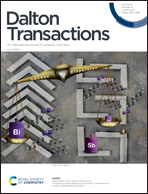Photothermal conversion performance and acid-induced aggregation of PLNP-Bi2S3 composite nanoplatforms
Abstract
Poly(sodium 4-styrenesulfonate) (PSS) molecule modified PLNP-Bi2S3 composite nanoplatforms were constructed by using polyvinylpyrrolidone (PVP) modified Bi2S3 nanoparticles (∼4.6 nm) as a photothermal agent and hexadecyl trimethyl ammonium bromide (CTAB) coated Zn2Ga2.98Ge0.75O8:Cr0.023+ (ZGGO:Cr3+@CTAB) persistent luminescence nanoparticles (PLNPs) through electrostatic adsorption. It is found that the above composite nanoplatforms have excellent laser-irradiation thermal stability and good photothermal conversion performance. The measured photothermal conversion efficiency is ∼44%, which is higher than that (∼37%) of the PLNP-GNR (gold nanorod) composite nanoplatforms. Meanwhile, PSS modified PLNP-Bi2S3 composite nanoplatforms exhibited good solution dispersibility in blood and normal tissue environments. While reaching tumor sites, the above composite nanoplatforms can be rapidly accumulated in cancer cells with acidic environments. This pH-responsive acid-induced aggregation can be ascribed to the chemical reaction induced by the protonation of PSS modified PLNP-Bi2S3 composite nanoplatforms with a negatively charged surface in the acidic environments. Our results suggest that PSS modified PLNP-Bi2S3 composite nanoplatforms might be applied to precision diagnosis and therapy of deep-tissue tumors.



 Please wait while we load your content...
Please wait while we load your content...